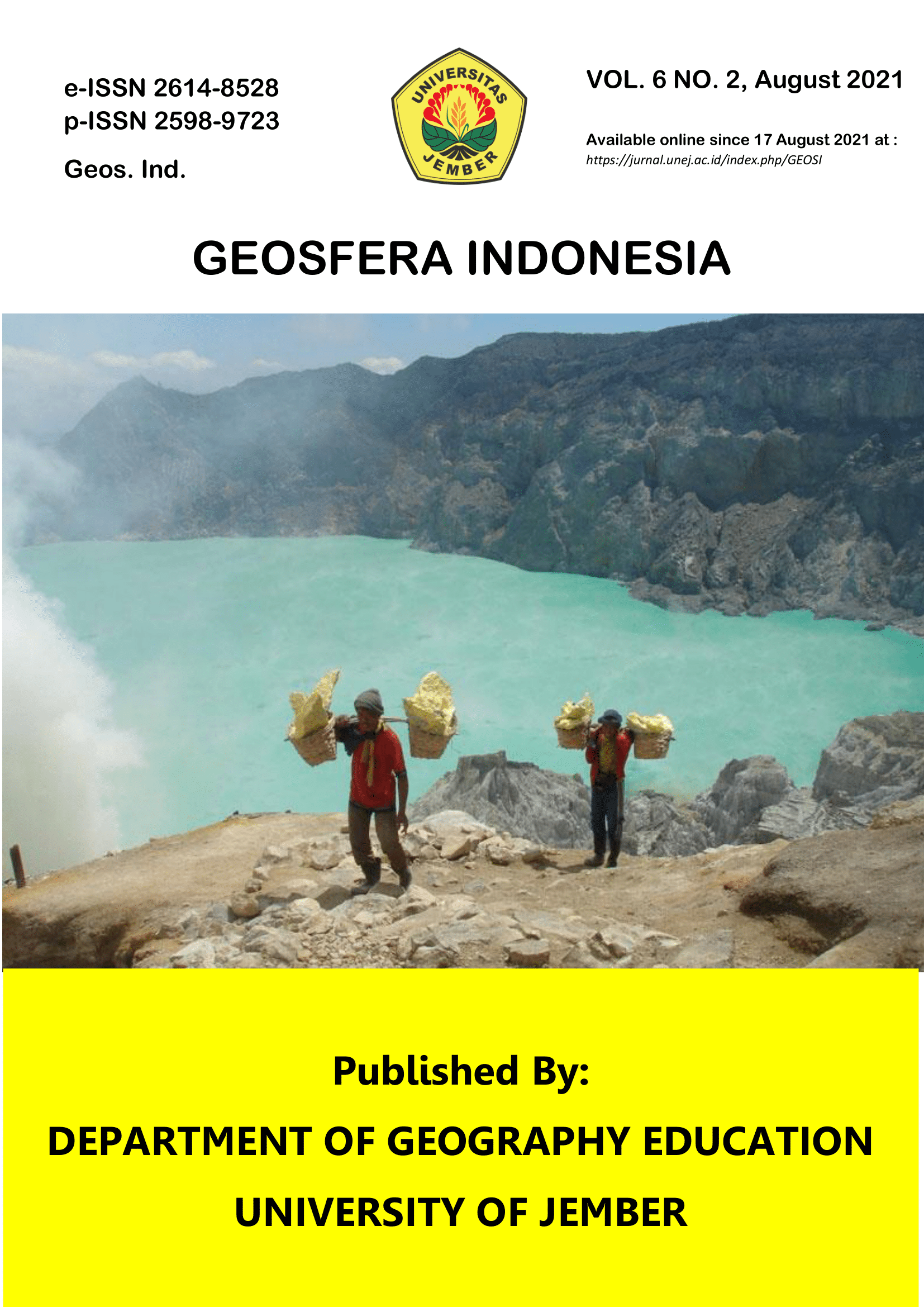Potential Utilization Analysis of River Waste in Jakarta, Indonesia
DOI:
https://doi.org/10.19184/geosi.v6i2.23297Keywords:
Solid waste, Water, Generation, Composition, UtilizationAbstract
There are still many people in Jakarta who throw their garbage into the river, resulting Jakarta city never being absent from the problems of river water pollution and flooding. Pesanggrahan River and Grogol River are some of the big river surrounded by high popullation area. All waste originating from the Pesanggrahan River and the Grogol River is dumped into the Bantar Gebang Landfill. This study aimed to reduce waste entering landfills are by making use of waste that still has economic value.The method used in decision making from various alternatives of the river waste utilization are utility theory and compromise programming. It takes planning to find out the composition and generation of solid waste from those rivers and to determine the potential use of river waste and the action to minimize and handle the river waste. Utilization of river waste that can be applied based on the composition of most waste is open windrow composting and plastic shredding. It is important to concern about river waste since Indonesia has various polluted river, especially by solid waste. By implementing a good river waste utilization, the waste that enters the landfill will be reduced and in line with reduced pollution to the aquatic environment.
Keywords: Solid waste; Water; Generation; Composition; Utilization
Copyright (c) 2021 Geosfera Indonesia and Department of Geography Education, University of Jember

This work is licensed under a Creative Commons Attribution-Share A like 4.0 International License
Downloads
References
Ayumi, I. d., Lutfi, M., & Nugroho, W. A. (2017). Efektivitas Tipe Pengomposan (Konvensional, Aerasi, dan Rak Segitiga) terhadap sifat fisik dan kimia kompos dari sludge biogas dan Serbuk Gergaji. Jurnal Keteknikan Pertanian Tropis dan Biosistem, 5(3), 265-272.
BPS. (2015). Profil Kependudukan Hasil SUPAS 2015 Provinsi DKI Jakarta. Jakarta: Badan Pusat Statistik (BPS).
Damanhuri, E., & Padmi, T. (2016). Pengelolaan Sampah Terpadu. Bandung: ITB.
DLH DKI Jakarta. (2020). Data-data TPST Bantar Gebang. Retrieved from Portal Resmi Pengelolaan Sampah Terpadu Dinas Lingkungan Hidup Provinsi DKI Jakarta: https://upst.dlh.jakarta.go.id/tpst/data.
ESRI (2016). ArcGIS Basemap. Retrieved from https://www.esri.com/en-us/home.
Fishburn, P. C. (1970). Utility theory and decision making. New York: John Wiley & Sons, inc.
Galgani, L., Beiras, R., Galgani, F., Panti, C., et al. (2019). Impacts of Marine Litter. Frontier in Marine Science, 4(11) https://doi.org/10.3389/fmars.2019.00208.
GESAMP, (2016). Sources, fate and effects of microplastics in the marine environment: a global assessment. London : International Maritime Organization.
Google (2020). Google Map. Retrieved from https://www.google.co.id/maps.
Hermabessiere, L., Dehaut, A., Paul-Pont, I., Lacroix, C., Jezequel, R., Soudant, P., et al. (2017). Occurrence and effects of plastic additives on marine environments and organisms: a review. Chemosphere, 182(1), 781–793. https://doi.org/10.1016/j.chemosphere.2017.05.096.
Jambeck, J. R., Geyer, R., Wilcox, C., Siegler, T. R., Perryman, M., Andrady, A., … Law, K. L. (2015). Plastic waste inputs from land into the ocean. Science, 347(6223), 768–771. https://doi.org/10.1126/science.1260352.
Karuniastuti, N. (2014). Teknologi biopori untuk mengurangi banjir dan tumpukan sampah organik . Swara Patra, 4(2), 60-68.
Khairunnisa, A. K., Fauziah, S. H., & Agamuthu, P. (2012). Marine debris composition and abundance: A case study of selected beaches in Port Dickson, Malaysia. Aquatic Ecosystem Health & Management, 15(3), 279–286. https://doi.org/10.1080/14634988.2012.703096.
Lyons, Y., Su, T. L., & Neo, M. L. (2019). A review of research on marine plastics in Southeast Asia: Who does what?. London: UK Science & Innovation Network.
Noerfitriyani, E. (2018). Impact of Leachate Discharge from Cipayung Landfill on Water Quality of Pesanggrahan River, Indonesia. IOP Conference Series: Earth and Environmental Science. https://doi.org/10.1088/1755-1315/120/1/012002.
Purba, N. P., Handyman, D. I. W., Pribadi, T. D., Syakti, A. D., Pranowo, W. S., Harvey, A., & Ihsan, Y. N. (2019). Marine debris in Indonesia: A review of research and status. Marine Pollution Bulletin, 146(C), 134–144. https://doi.org/10.1016/j.marpolbul.2019.05.057.
Ratna, D. A. (2017). Pengaruh kadar air terhadap proses pengomposan sampah organik dengan metode takakura. Jurnal Teknik Mesin, 6(2), 124–128. https://doi.org/10.22441/jtm.v6i2.1192.
Sahwan, F. L. (2010). Kualitas produk kompos dan karakteristik proses pengomposan sampah kota tanpa pemilahan awal. Jurnal Teknologi Lingkungan, 11(1), 79–85. https://doi.org/10.29122/jtl.v11i1.1225.
Selvam, K., Xavier, K. A. M., Shivakrishna, A., Bhutia, T. P., Kamat, S., & Shenoy, L. (2020). Abundance, composition and sources of marine debris trawled-up in the fishing grounds along the north-east Arabian coast. Science of the Total Environment, 751(C), 141771. https://doi.org/10.1016/j.scitotenv.2020.141771.
Tarverdi, K. (2010). Improving the mechanical recycling and reuse of mixed plastics and polymer composites. Management, Recycling and Reuse of Waste Composites, Amsterdam : Elsevier.
Tchobanoglous, G., & Kreith, F. (2002). Handbook of Solid Waste Management. New York: McGraw-Hill International.
UNEP (2014). Valuing Plastics: The Business Case for Measuring, Managing and Disclosing Plastic Use in the Consumer Goods Industry. Nairobi: U.N.E. Program.
United Nation ESCAP. (2012). Operational Manual on Composting for an Integrated Resource Recovery Center (IRRC). Bangkok: ESCAP.
United Nation ESCAP. (2015). Sustainable Development Goals. Bangkok: ESCAP.
UPK Badan Air. (2019). Rekapitulasi Volume Sampah UPK Badan Air November 2019. Retrived from : https://statistik.jakarta.go.id/.
Wahyono, S., & Sahwan, F. (2010). Analisa biaya mekanisasi produksi kompos sistem windrow (studi kasus komposting di RPH Cakung-Jakarta Timur). Jurnal Teknologi Lingkungan, 11 (1), 87-93.
Waste Management Law (2008). Undang-Undang Republik Indonesia tentang Pengelolaan Sampah. Retrieved from https://peraturan.bpk.go.id/Home/Details/39067/uu-no-18-tahun-2008.
World Bank Group. (2018). Hot Spot Sampah Laut Indonesia. Jakarta: World Bank.
Yusfi, R. N., & Damanhuri, T. P. (2012). Studi Karakteristik dan Potensi Daur Ulang Sampah di Bantaran Sungai Cikapundung. Jurnal Teknik Lingkungan, 18(2), 155–166. https://doi.org/10.5614/jtl.2012.8.2.6.



